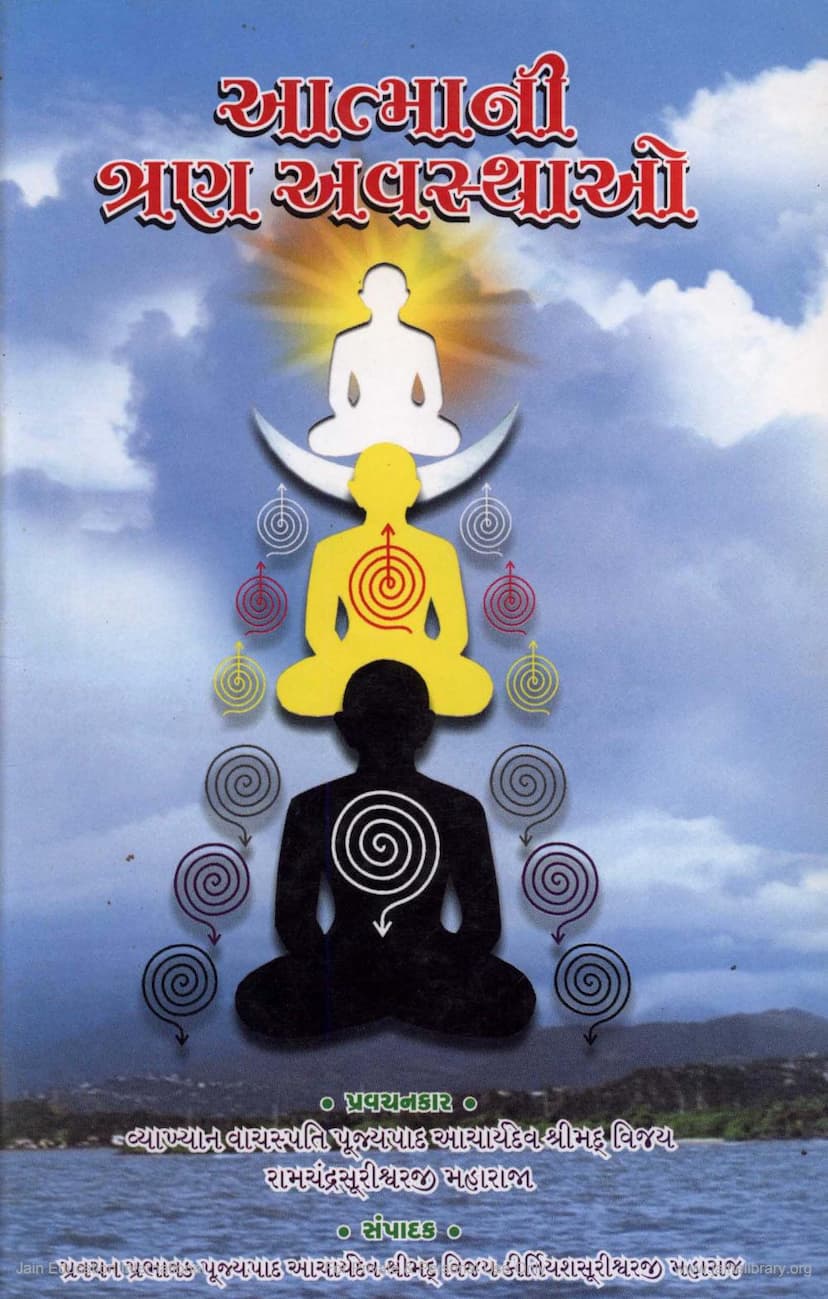Atmani Tran Avasthao
Added to library: September 1, 2025

Summary
Here's a comprehensive summary of the Jain text "Atmani Tran Avasthao" (Three States of the Soul) by Acharya Shrimad Vijay Ramchandrasurishwarji Maharaj, compiled by Acharya Shrimad Vijay Kirtiyashsurishwarji Maharaj, published by Sanmarg Prakashan.
The book, published in Gujarati, delves into the fundamental Jain philosophy of the soul and its various states, aiming to guide the reader towards spiritual progress and ultimate liberation (Moksha).
Core Concepts and Structure:
The central theme of the book revolves around the three states of the soul:
-
Bahiratama (External Soul): This is the state where the soul is identified with the physical body and the external world. The focus is on worldly possessions, sensory pleasures, and external recognition. The Bahiratama is engrossed in worldly affairs, driven by desires and attachments, and has little to no awareness of its true spiritual nature.
-
Antaratama (Internal Soul): This state represents a stage of spiritual awakening where the soul begins to turn inward. There's a growing awareness of the self as distinct from the body and the external world. The Antaratama seeks inner peace, engages in spiritual practices, and strives to shed karmic impurities. This is a state of introspection and a conscious effort towards self-improvement.
-
Paramatma (Supreme Soul): This is the ultimate state of the soul, achieved through complete freedom from karmas and identification with its true, pure, and liberated nature. The Paramatma possesses infinite knowledge, perception, power, and bliss. It is the state of Moksha, where the soul is free from the cycle of birth and death.
Key Teachings and Arguments:
The book elaborates on these states through various points:
- The Existence of the Soul: The text strongly emphasizes the existence of the soul as distinct from the body. It argues that accepting this fundamental truth is essential for any spiritual progress.
- The Nature of Karma: The book highlights the role of karma in shaping the soul's experiences and its current state. Karmas are seen as coverings that obscure the soul's inherent pure nature.
- The Illusion of Worldly Attachments: A significant portion of the text is dedicated to dissecting the nature of worldly attachments, possessions, and pleasures. It argues that these are temporary and ultimately lead to suffering. The book uses vivid examples to illustrate how attachments to wealth, status, and even physical necessities like air and water, are forms of bondage.
- The Importance of Right Perspective (Samyaktva): True spiritual progress begins with developing a right perspective, which involves understanding the soul's true nature and the impermanence of the material world. This is achieved through developing faith in the Jain principles, particularly the existence of the soul, karma, and the path to liberation.
- The Role of Spiritual Practices: The text advocates for various spiritual practices, such as contemplation, adherence to ethical principles, detachment, and devotion to the Tirthankaras and spiritual preceptors. These practices are presented as the means to shed karmas and ascend to higher spiritual states.
- The Cycle of Birth and Death: The book explains how the soul, due to its karmic bondage, continues to traverse the cycle of birth and death (Samsara), experiencing pleasure and pain. The ultimate goal is to break free from this cycle.
- The Ideal of the Ascetic: The life of a renunciate (Sadhuji) is presented as a path that directly leads to the shedding of worldly desires and the realization of the soul's true nature. However, the text also emphasizes that even those living in the world can make spiritual progress through devotion to ascetics and adherence to Dharma.
- Critical Examination of Beliefs: The book encourages introspection and self-assessment. It challenges readers to examine their own beliefs and practices, questioning whether their adherence to Dharma is superficial or deeply ingrained. It emphasizes that merely performing rituals without genuine understanding and inner transformation is not sufficient.
- The Need for Inner Purity: The text repeatedly stresses the importance of inner purity, detachment, and a constant remembrance of the soul's eternal nature. It contrasts the fleeting nature of worldly happiness with the eternal bliss of the liberated soul.
- The Path to Liberation (Moksha): The ultimate aim is Moksha, the state of liberation. This is achieved by transcending the Bahiratama state, cultivating the Antaratama state, and ultimately reaching the Paramatma state. The book implicitly guides the reader on this journey by elaborating on the necessary mindset and practices.
- The Six Places of Mithyatva and Samyaktva: A significant section discusses the six principles that define false belief (Mithyatva) and the six principles that define right belief (Samyaktva). Understanding these is crucial for discerning the right spiritual path.
Key Message:
The overarching message of "Atmani Tran Avasthao" is to awaken the individual's consciousness to the true nature of the soul and the impermanence of the material world. It serves as a spiritual guide, urging readers to detach from worldly illusions, cultivate inner awareness, and actively engage in practices that lead to the purification of the soul and ultimate liberation. The book is a call to move from a state of external identification to inner realization and spiritual perfection.